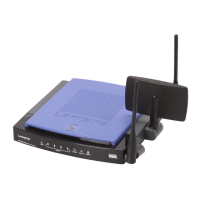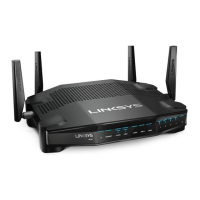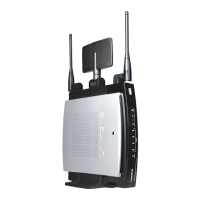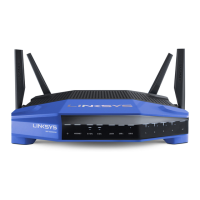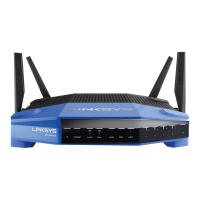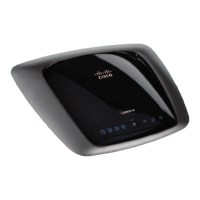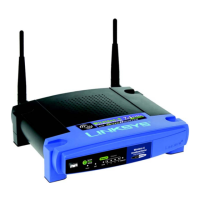Do you have a question about the Linksys WRT300N and is the answer not in the manual?
Welcome message and overview of the router's capabilities.
Outlines the structure and content of the user guide.
Describes the structure and layout of a wireless network.
Explains the two primary modes for wireless network setup.
Details how the router connects to various network devices.
Describes the ports and buttons located on the rear of the router.
Details the LEDs and indicators on the front of the router.
Mentions a button reserved for future functionality on the top panel.
Provides step-by-step instructions for physical installation of the router.
Introduces the web-based utility and main configuration tabs.
Guides users on how to access the router's configuration interface.
Covers initial Internet and network connection type settings.
Explains how to configure Dynamic Domain Name System for hosting services.
Details how to clone a PC's MAC address for ISP requirements.
Allows configuration of dynamic and static routing settings.
Configures essential wireless network parameters like SSID and mode.
Sets up security modes, encryption, and keys for wireless networks.
Filters wireless access based on MAC addresses of devices.
Adjusts advanced wireless parameters to optimize performance.
Configures firewall protection and network filters.
Allows VPN tunnels (IPSec, L2TP, PPTP) to pass through the router.
Manages internet access rules, blocking/allowing traffic by time and content.
Customizes port services for specific applications.
Sets up public services or specialized Internet applications.
Monitors outgoing data for specific port numbers.
Exposes one PC to the Internet for special-purpose services like gaming.
Prioritizes network traffic for demanding applications and devices.
Manages router access, UPnP, and configuration backup/restore.
Provides logs of incoming/outgoing traffic and activity.
Performs diagnostic tests like Ping and Traceroute.
Restores the router's configuration to its original factory settings.
Guides on how to upgrade the router's firmware.
Displays information about the router's current settings and firmware.
Shows information about the local network and DHCP clients.
Displays the status of the wireless network and its configuration.
Provides solutions for common issues encountered during setup and operation.
Answers common questions about the router's functionality and features.
Lists essential steps to secure your wireless network.
Discusses common threats and how to mitigate them.
Explains the importance of TCP/IP for network communication.
Guides on sharing printers, folders, and files using Windows Help.
Describes how to view and add PCs to the network.
Provides steps to find MAC/IP addresses on Windows 98SE/Me.
Provides steps to find MAC/IP addresses on Windows 2000/XP.
Explains how to use the router's utility for MAC filtering and cloning.
Details compliance with FCC rules for digital devices.
States FCC limits for radiation exposure.
Provides safety precautions for product usage.
States compliance with Canadian ICES-003 and RSS210 rules.
Information regarding compliance with EU R&TTE Directive for wireless products.
Lists country-specific limitations on product usage.
Details restrictions on product usage, such as indoor-only operation.
Provides instructions for adjusting power output for wireless adapters.
Welcome message and overview of the router's capabilities.
Outlines the structure and content of the user guide.
Describes the structure and layout of a wireless network.
Explains the two primary modes for wireless network setup.
Details how the router connects to various network devices.
Describes the ports and buttons located on the rear of the router.
Details the LEDs and indicators on the front of the router.
Mentions a button reserved for future functionality on the top panel.
Provides step-by-step instructions for physical installation of the router.
Introduces the web-based utility and main configuration tabs.
Guides users on how to access the router's configuration interface.
Covers initial Internet and network connection type settings.
Explains how to configure Dynamic Domain Name System for hosting services.
Details how to clone a PC's MAC address for ISP requirements.
Allows configuration of dynamic and static routing settings.
Configures essential wireless network parameters like SSID and mode.
Sets up security modes, encryption, and keys for wireless networks.
Filters wireless access based on MAC addresses of devices.
Adjusts advanced wireless parameters to optimize performance.
Configures firewall protection and network filters.
Allows VPN tunnels (IPSec, L2TP, PPTP) to pass through the router.
Manages internet access rules, blocking/allowing traffic by time and content.
Customizes port services for specific applications.
Sets up public services or specialized Internet applications.
Monitors outgoing data for specific port numbers.
Exposes one PC to the Internet for special-purpose services like gaming.
Prioritizes network traffic for demanding applications and devices.
Manages router access, UPnP, and configuration backup/restore.
Provides logs of incoming/outgoing traffic and activity.
Performs diagnostic tests like Ping and Traceroute.
Restores the router's configuration to its original factory settings.
Guides on how to upgrade the router's firmware.
Displays information about the router's current settings and firmware.
Shows information about the local network and DHCP clients.
Displays the status of the wireless network and its configuration.
Provides solutions for common issues encountered during setup and operation.
Answers common questions about the router's functionality and features.
Lists essential steps to secure your wireless network.
Discusses common threats and how to mitigate them.
Explains the importance of TCP/IP for network communication.
Guides on sharing printers, folders, and files using Windows Help.
Describes how to view and add PCs to the network.
Provides steps to find MAC/IP addresses on Windows 98SE/Me.
Provides steps to find MAC/IP addresses on Windows 2000/XP.
Explains how to use the router's utility for MAC filtering and cloning.
Details compliance with FCC rules for digital devices.
States FCC limits for radiation exposure.
Provides safety precautions for product usage.
States compliance with Canadian ICES-003 and RSS210 rules.
Information regarding compliance with EU R&TTE Directive for wireless products.
Lists country-specific limitations on product usage.
Details restrictions on product usage, such as indoor-only operation.
Provides instructions for adjusting power output for wireless adapters.
| Bandwidth | 2.4 GHz |
|---|---|
| xDSL connection | No |
| Dimensions (WxDxH) | 188 x 176 x 40 mm |
| Power requirements | 12 V, 1 A |
| Maximum data transfer rate | 0.1 Gbit/s |
| Compatible operating systems | Windows 2000 / XP |
| Supported data transfer rates | WLAN: 1, 2, 5.5, 6, 9, 11, 12, 18, 24, 36, 48, 54 Mbps |
| Full duplex | Yes |
| VPN support | L2TP, PPTP, IPSec, PPPoE |
| Switching protocols | Fast Ethernet, WLAN |
| Authentication method | RADIUS, SSID |
| Certification | FCC, CE, IC-03 |
| Storage temperature (T-T) | -20 - 70 °C |
| Operating temperature (T-T) | 0 - 40 °C |
| Storage relative humidity (H-H) | 5 - 90 % |
| Operating relative humidity (H-H) | 10 - 85 % |
| Ethernet LAN (RJ-45) ports | 5 |
| Weight | 527 g |
|---|
